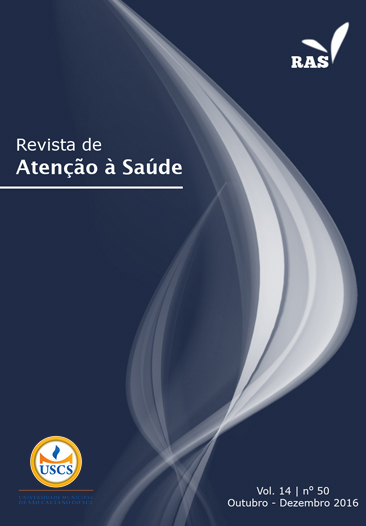Métodos de tratamento da disfunção temporomandibular: revisão sistemática
DOI:
https://doi.org/10.13037/ras.vol14n50.3784Palavras-chave:
conduta do tratamento medicamentoso, síndrome da disfunção da articulação temporomandibular, oclusão dentária, aconselhamento, revisão.Resumo
Introdução: A disfunção temporomandibular (DTM) é uma alteração gerada por meio de vários distúrbios e que pode afetar os músculos mastigatórios, a articulação temporomandibular, ou ambos. Objetivo: Abordar formas de tratamento para a DTM, como também o seu manejo clínico interdisciplinar, na condução de um quadro de DTM sintomático à reabilitação definitiva. Materiais e Métodos: Trata-se de um estudo teórico, do tipo revisão sistemática, fundamentado em pesquisa bibliográfica de artigos da base de dados eletrônicos PubMed e Biblioteca Cochrane, conduzida por três revisores independentes. Incluiu artigos entre o período de janeiro de 2009 e janeiro de 2014. Resultados: Foram encontrados 929 registros, sendo selecionados treze estudos. A verificação do material permitiu identificar que os dispositivos interoclusais efetivos e mais utilizados foram a placa oclusal, seguido do front platô. Dentro das medicações, o ibuprofeno e o diazepam foram os fármacos encontrados e utilizados nos estudos. O aconselhamento, como mudanças de comportamento, postura de sono, orientações sobre dieta e inibição de hábitos orais nocivos foram encontrados. Na abordagem multiprofissional pode-se verificar a acupuntura e a laserterapia, os quais podem gerar alívio da dor. Conclusão: Percebe-se que as modalidades de tratamento para a DTM são acessíveis e diversas, cabendo ao profissional a escolha da terapia que mais se encaixa no perfil do paciente após um correto planejamento.
Downloads
Referências
Godoy CH, Silva PF, Araujo DS, Motta LJ, Biasotto-Gonzalez DA, Politti F et al. Evaluation of effect of low-level laser therapy on adolescents with temporomandibular disorder: study protocol for a randomized controlled trial. Trials. 2013;14:229.
Maluf SA, Moreno BG, Crivello O, Cabral CM, Bortolotti G, Marques AP. Global postural reeducation and static stretching exercises in the treatment of myogenic temporomandibular disorders: a randomized study. J Manip Physiol Ther. 2010;33(7):500-7.
Madani AS, Mirmortazavi A. Comparison of three treatment options for painful temporomandibular joint clicking. J Oral Sci. 2011;53(3):349-54.
Vuckovic NH, Williams LA, Schneider J, Ramirez M, Gullion CM. Long-term outcomes of shamanic treatment for temporomandibular joint disorders. Perm J. 2012;16(2):28-35.
Ernberg M, Hedenberg-Magnusson B, List T, Svensson P. Efficacy of botulinum toxin type A for treatment of persistent myofascial TMD pain: a randomized, controlled, double-blind multicenter study. Pain. 2011;152(9):1988-96.
Marini I, Gatto MR, Bonetti GA. Effects of superpulsed low-level laser therapy on temporomandibular joint pain. Clin J Pain. 2010;26(7):611-6.
Nascimento MM, Vasconcelos BC, Porto GG, Ferdinanda G, Nogueira CM, Raimundo RD. Physical therapy and anesthetic blockage for treating temporomandibular disorders: a clinical trial. Med Oral Patol Oral Cir Bucal. 2013;18(1):e81-5.
Venezian GC, Silva MA, Mazzetto RG, Mazzetto MO. Low level laser effects on pain to palpation and electromyographic activity in TMD patients: a double-blind, randomized, placebo-controlled study. Cranio. 2010;28(2):84-91.
Litt MD, Shafer DM, Kreutzer DL. Brief cognitive-behavioral treatment for TMD pain: long-term outcomes and moderators of treatment. Pain. 2010;151(1):110-6.
Hara ES, Witzel AL, Luca CE, Ballester RY, Kuboki T, Bolzan MC. A novel vibratory stimulation-based occlusal splint for alleviation of TMD painful symptoms: a pilot study. J Oral Rehabil. 2013;40(3):179-84.
Tavera AT, Montoya MC, Calderón EF, Gorodezky G, Wixtrom RN. Approaching temporomandibular disorders from a new direction: a randomized controlled clinical trial of the TMDes ear system. Cranio. 2012;30(3):172-82.
Abrahamsen R, Zachariae R, Svensson P. Effect of hypnosis on oral function and psychological factors in temporomandibular disorders patients. J Oral Rehabil. 2009;36(8):556-70.
Hamata MM, Zuim PR, Garcia AR. Comparative evaluation of the efficacy of occlusal splints fabricated in centric relation or maximum intercuspation in temporomandibular disorders patients. J Appl Oral Sci. 2009;17(1):32-8.
Tuncer AB, Ergun N, Tuncer AH, Karahan S. Effectiveness of manual therapy and home physical therapy in patients with temporomandibular disorders: a randomized controlled trial. J Bodyw Mov Ther. 2013;17(3):302-8.
Ferrando M, Galdón MJ, Durá E, Andreu Y, Jiménez Y, Poveda R. Enhancing the efficacy of treatment for temporomandibular patients with muscular diagnosis through cognitive-behavioral intervention, including hypnosis: a randomized study. Oral Surg Oral Med Oral Pathol Oral Radiol. 2012;113(1):81-9.
Hotta PT, Hotta TH, Bataglion C, Bataglion SA, Souza Coronatto EA, Siéssere S et al. Emg analysis after laser acupuncture in patients with temporomandibular dysfunction (TMD): implications for practice. Complement Ther Clin Pract. 2010;16(3):158-60.
Alencar F Jr., Becker A. Evaluation of different occlusal splints and counselling in the management of myofascial pain dysfunction. J Oral Rehabil. 2009;36(2):79-85.
Ficnar T, Middelberg C, Rademacher B, Hessling S, Koch R, Figgener L. Evaluation of the effectiveness of a semi-finished occlusal appliance: a randomized, controlled clinical trial. Head Face Med. 2013;9:5.
Kalamir A, Bonello R, Graham P, Vitiello AL, Pollard H. Intraoral myofascial therapy for chronic myogenous temporomandibular disorder: a randomized controlled trial. J Manipulative Physiol Ther. 2012;35(1):26-37.
Guarda-Nardini L, Stecco A, Stecco C, Masiero S, Manfredini D. Myofascial pain of the jaw muscles: comparison of short-term effectiveness of botulinum toxin injections and fascial manipulation technique. Cranio. 2012;30(2):95-102.
Cuccia AM, Caradonna C, Annunziata V, Caradonna D. Osteopathic manual therapy versus conventional conservative therapy in the treatment of temporomandibular disorders: a randomized controlled trial. J Bodyw Mov Ther. 2010;14(2):179-84.
Elder C, Ritenbaugh C, Aickin M, Hammerschlag R, Dworkin S, Mist S et al. Reductions in pain medication use associated with traditional Chinese medicine for chronic pain. Perm J. 2012;16(3):18-23.
Ozkan F, Cakir Özkan N, Erkorkmaz U. Trigger point injection therapy in the management of myofascial temporomandibular pain. Agri. 2011;23(3):119-25.
Daif ET. Correlation of splint therapy outcome with the electromyography of masticatory muscles in temporomandibular disorder with myofascial pain. Acta Odontol Scand. 2012;70(1):72-7.
Doepel M, Nilner M, Ekberg E, Vahlberg T, Bell YI. Headache: short- and long-term effectiveness of a prefabricated appliance compared to a stabilization appliance. Acta Odontol Scand. 2011;69(3):129-36.
Doepel M, Nilner M, Ekberg E, LE Bell Y. Long-term effectiveness of a prefabricated oral appliance for myofascial pain. J Oral Rehabil. 2012;39(4):252-60.
Nilsson H, Vallon D, Ekberg EC. Long-term efficacy of resilient appliance therapy in TMD pain patients: a randomised, controlled trial. J Oral Rehabil. 2011;38(10):713-21.
Nilsson H, Limchaichana N, Nilner M, Ekberg EC. Short-term treatment of a resilient appliance in TMD pain patients: a randomized controlled trial. J Oral Rehabil. 2009;36(8):547-55.
Pramod GV, Shambulingappa P, Shashikanth MC, Lele S. Analgesic efficacy of diazepam and placebo in patients with temporomandibular disorders: a double blind randomized clinical trial. Indian J Dent Res. 2011;22(3):404-9.
Conti PC, Alencar EN, Correa ASM, Lauris JR, Porporatti AL, Costa YM. Behavioural changes and occlusal splints are effective in the management of masticatory myofascial pain: a short-term evaluation. J Oral Rehabil. 2012;39(10):754-60.
Niemelä K, Korpela M, Raustia A, Ylöstalo P, Sipilä K. Efficacy of stabilisation splint treatment on temporomandibular disorders. J Oral Rehabil. 2012;39(11):799-804.
Michelotti A, Iodice G, Vollaro S, Steenks MH, Farella M. Evaluation of the short-term effectiveness of education versus an occlusal splint for the treatment of myofascial pain of the jaw muscles. J Am Dent Assoc. 2012;143(1):47-53.
Simma I, Gleditsch JM, Simma L, Piehslinger E. Immediate effects of microsystem acupuncture in patients with oromyofacial pain and craniomandibular disorders (CMD): a double-blind, placebo-controlled trial. Br Dent J. 2009;207(12):E26.
Vicente-Barrero M, Yu-Lu SL, Zhang B, Bocanegra-Pérez S, Durán-Moreno D, López-Márquez A et al. The efficacy of acupuncture and decompression splints in the treatment of temporomandibular joint pain-dysfunction syndrome. Med Oral Patol Oral Cir Bucal. 2012;17(6):e1028-33.
Öz S, Gökçen-Röhlig B, Saruhanoglu A, Tuncer EB. Management of myofascial pain: low-level laser therapy versus occlusal splints. J Craniofac Surg. 2010;21(6):1722-8.
Downloads
Publicado
Edição
Seção
Licença
Proposta de Política para Periódicos que oferecem Acesso Livre Adiado
Autores que publicam nesta revista concordam com os seguintes termos:
- Autores mantém os direitos autorais e concedem à revista o direito de primeira publicação, com o trabalho licenciado simultaneamente sob uma licença
https://creativecommons.org/licenses/by-nc-nd/4.0/, permitindo o compartilhamento do trabalho com reconhecimento da autoria do trabalho e publicação inicial nesta revista.
- Autores têm autorização para assumir contratos adicionais separadamente, para distribuição não-exclusiva da versão do trabalho publicada nesta revista (ex.: publicar em repositório institucional ou como capítulo de livro), com reconhecimento de autoria e publicação inicial nesta revista.
- Autores têm permissão e são estimulados a publicar e distribuir seu trabalho online (ex.: em repositórios institucionais ou na sua página pessoal) a qualquer ponto antes ou durante o processo editorial, já que isso pode gerar alterações produtivas, bem como aumentar o impacto e a citação do trabalho publicado (Veja O Efeito do Acesso Livre).






